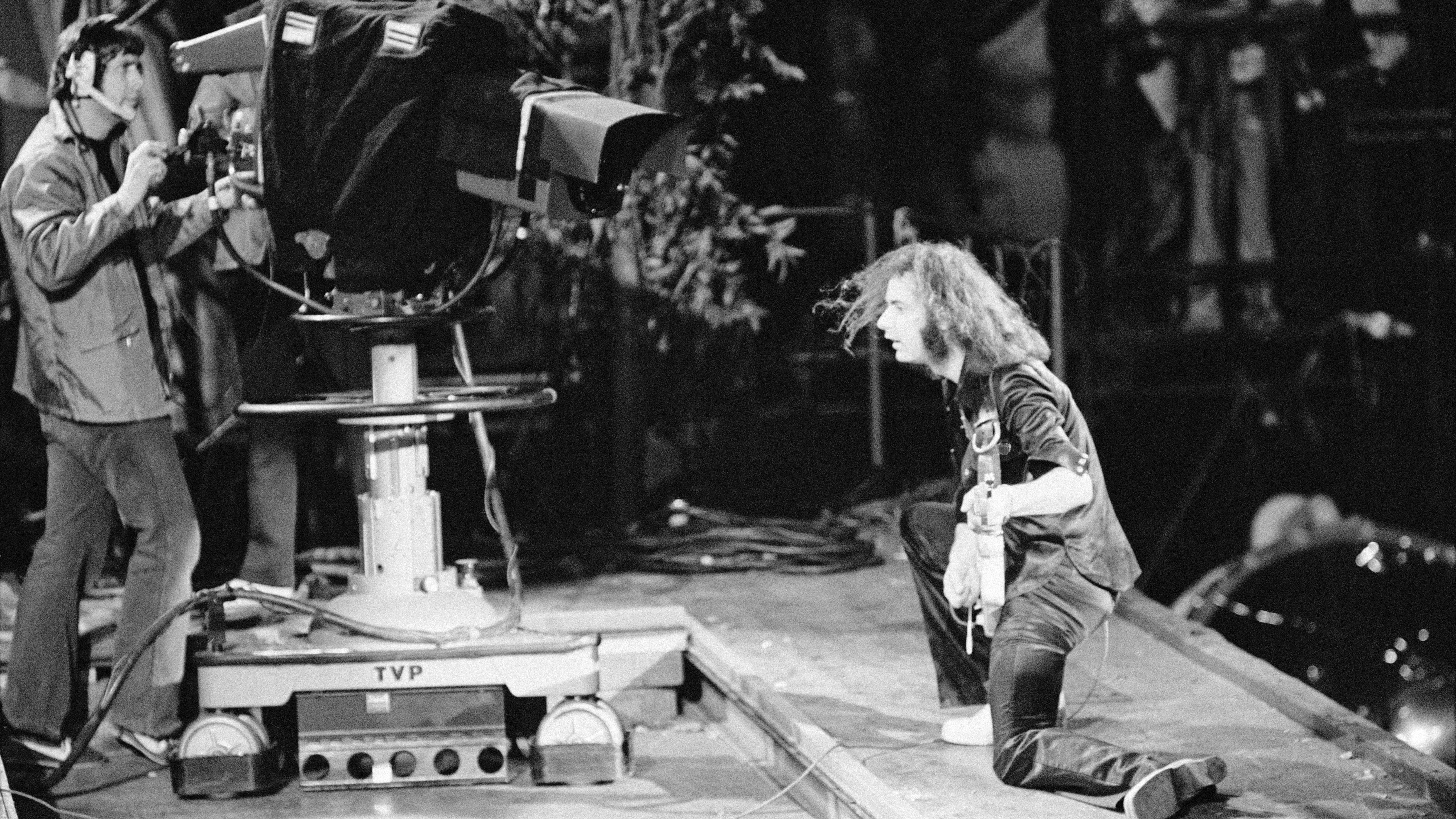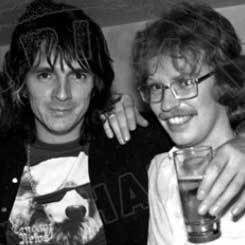The California Jam was probably the last great crazy-as-fuck American rock’n’roll festival – as David Coverdale will tell you. He played there with a cheque for a million dollars tucked in the back pocket of his jeans.
The California Jam took place at Ontario Speedway in California (natch) on April 6, 1974, in front of 200,000 rabid rock fans. At least that was the official attendance.
Unofficially there were likely twice as many people there. Deep Purple – who had recently appointed Coverdale as their vocalist – were the biggest-selling album act in the US at the time. They were in the midst of a major tour promoting Burn – the first album recorded by the Mk III line-up of the band: Ritchie Blackmore (guitar), Jon Lord (keyboards), Ian Paice (drums) and new boys Glenn Hughes (bass) and Coverdale. The latter two had replaced Roger Glover and Ian Gillan, respectively, in 1973.
The California Jam was a humungous affair. Major portions of it were broadcast live on America’s ABC television network, which was also a sponsor of the show. Other bands on the bill included Black Sabbath, Black Oak Arkansas, The Eagles, Emerson Lake & Palmer, Earth Wind & Fire and, erm, Rare Earth and Seals & Crofts. But Purple were the star attraction.
Their sensational performance – fuelled by backstage aggro – climaxed in an orgy of destruction by Blackmore. At the end of Space Truckin’ he smashed his Stratocaster repeatedly into a camera operator’s lens. He went on to destroy several more guitars before a madder-than-expected explosion in his Marshall stacks set his hair on fire. And Ian Paice’s. And most of the road crew’s. Impressive stuff, especially if your name is Christopher Guest.
Purple’s California Jam performance was one of the first rock shows to be filmed and put on sale on the then spanking new ‘video’ format. And in 2005 it was released on DVD – with a wealth of bonus features plus the addition of Lay Down Stay Down, which wasn’t on the original VHS.
Classic Rock talked to David Coverdale and Glenn Hughes about what was arguably Deep Purple Mk III’s finest hour.

How many people attended the California Jam, in your estimation?
Glenn Hughes: There were maybe 350,000 or 400,000 people there altogether. The fences came down and they all rushed in. Deep Purple were actually on fire back then. It was the first big stadium tour for David and me. The California Jam was really huge. It was a great moment for us.
What about your cheque for $1 million?
David Coverdale: It’s true – I should’ve done a runner there and then. But I don’t think it was Purple’s fee for the actual gig; I believe it was a royalty cheque from Warner Brothers [Purple’s US label]. I was wearing the most expensive pair of fucking jeans on the planet.
You retain vivid memories of that day.
GH: It was when the world was fresh, everything was rosy and fantastic, and I was drinking lemonade. I remember very clearly what was going on. One of the higher-ups at Warner Brothers even bought me an expensive white suit to wear on stage. The idea was to make a contrast with Ritchie, who was known as the Man In Black.
DC: I loved it. Recently my webmaster and I obtained a very good quality bootleg of the show, and we whacked it on to my website. Of course it’s out on DVD now, so it looks like we’re going to have to withdraw it.
What’s the story behind the bonkers climax to the set?
DC: We were supposed to go on stage at sunset. That was actually written into our contract. But the California Jam was running ahead of schedule. We’d just flown in by helicopter and I remember being in my backstage caravan, pouring myself a scotch and Coke, when somebody came in and said: “It’s time for you to get out on stage.”
Blackmore was very cheesed off when he was asked to go on stage early.
DC: Ritchie wanted Purple to be the first band to use lights on stage. He refused to go on stage until the contracted time, and he was absolutely correct. I remember someone saying: “Do you know who you’re dealing with there?” There was inference the Mafia was involved.
GH: There was lots of screaming and yelling. Ritchie locked the door to his trailer. They had to break in to get him out of there. Was there a chance Purple’s show might not have gone ahead?
DC: Yes. The festival organiser told us: “Right, that’s it, we’re pulling the plug. You’re all going to fucking hell.” And he stormed off to announce that we wouldn’t be appearing. Luckily our tour manager, Ossie Hoppe, beat him in a race to the stage. Ossie grabbed the mic and shouted to the crowd: “Do you wanna see Deep Purple?!” And a quarter of a million people went: “Yeah!”
All the problems certainly gave an edge to Purple’s performance.
GH: We managed to delay by about 20 minutes but the sun only went down about halfway through our set. But it fired us up; it gave a bit of an edge to our performance. Ritchie had a bit of a moan – he hadn’t had time to change into his stage clothes. Then Blackmore attacked a cameraman.
DC: That was never supposed to be part of the show, to smack the cameraman. But he was on Ritchie’s arse from the word go. Ritchie would do his thoughtful, melodic little pieces and there’d be this abrasive voice going: “Hey, step back so I can get a decent shot of you.”
What about the explosive climax?
DC: It went a bit too far. There was too much explosive. It looks great, I agree, but Ritchie got burned, Paicey got burned, and some of the crew got burned. Thankfully it was nothing too serious.
GH: We sold a lot of records and concert tickets in America after that. It was a big, bold statement and it deserves its place in rock’s history books.
How could ELP have followed that?
GH: I want to make this clear – Purple were the headliners. A few months before, we added ELP to bring some more people in. But we chose not to go on last [as ELP did]. All I can say is that the freeway was jam packed with cars as we left.
1974 was an amazing year for Purple.
GH: It was a fabulous year. You could actually see the band uniting on stage on that American tour, culminating in the California Jam appearance. It’s the Mk III line-up in all its glory.
DC: Contrary to reports, Purple was a happy camp. I still appreciate the incredible courage Purple had in taking me on. I was unknown before I joined them. I’d like to reconnect with Blackers and say to him: “Thanks a fucking bunch.”
When Purple did Smoke On The Water, the lyrics were changed from ‘We all came down to Montreux’ to ‘They all came down to Montreux’.
DC: That was a tip of the hat to the Mk II line-up.
GH: Mk II were a great band. But I thought the beauty of Mk III was having two new guys come in that were totally different to the other chaps. It was a bold move.
David, you also grappled with an extraordinary L-shaped mic stand at the California Jam.
DC: That stand was my idea. I wanted to have my own identity on stage.
The ‘rainbow arch’ effect at the back of the California Jam stage obviously gave Blackmore some ideas for the future.
GH: Absolutely. It really did.
Is it true that Linda Lovelace knocked on the door of Purple’s trailer – but was ignored?
DC: Yes. Nobody had heard of her at the time, so she wasn’t allowed in. That ruined my reputation!
What do you think when you look back at the California Jam footage now?
DC: When I see it I realise I learned shitloads from that performance. It helped set me on my way.
GH: I love playing in front of a lot of people. You can see that from the show footage. I was ready for that. I was born to play the California Jam.
This feature originally appeared in the Classic Rock 70s Special, in December 2005.

